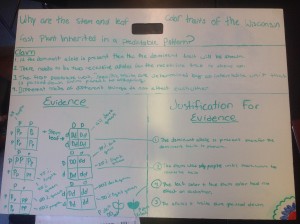Can we have an argument, please? (1)
So I’ve been experimenting with argumentation in my classroom this year and I am really excited about the prospects. There are many improvements to be made, but I would like to share my experience with you thus far. In this post I’ll discuss the process. I will share actual argumentation lessons and how they’ve gone in subsequent posts.
At the end of last school year, during a department meeting, the topic of modeling instruction came up. One of our physics teachers had attended a physics modeling workshop over the summer and was implementing the ideas into his classroom. Asked if interested, most of our biology department seemed intrigued by this idea. We started with everyone, 4 full-time biology teachers, getting a class set of white boards (1, 4×8 sheet of hardboard panel board can be cut into 4, 2×3 pieces, with a bit left over for smaller boards). The idea was to have a 2×3 board for each group of students. Since I have 5 sections of biology with 7 groups in each section, I ended up with 35 boards. It is important that each group get their own board as they may be working on it over several days. The other thing that came up was getting us into a biology modeling instruction workshop. Funds for travel, lodging, and workshopping are somewhat limited especially for 4-5 biology teachers, so, under pressure from us and our department head, our district is bringing in an outside “expert” this summer to conduct the two-week workshop! (By the way, if any of you are using modeling in the biology classroom or have been to training, I would love to hear about your experience.)
OK. So now that I have whiteboards in my classroom, how am I going to use them. At first, it was a really nice tool for groups of student to show and share data that they were collecting from experiments or a way for them to make a graph from their data and share it with the rest of the class. In the middle of last semester, my student teacher and I developed an argumentation lesson that really made me think about how powerful this piece could be in the classroom.
Argumentation can look a couple of different ways, but we modeled our first lesson after information we found in two different sources, both from NSTA Press.
- “Argument-Driven Inquiry Biology: Lab Investigations for Grades 9-12” and
- “Scientific Argumentation in Biology: 30 Classroom Activities”
Here’s the general idea:
- A question is presented.
- Students design an experiment that they believe will answer the question.
- Students will make a claim regarding the question.
- Students will provide evidence from their experiment supporting their claim.
- Students will justify the evidence that they have chosen.
- Claims, evidence, and justification will undergo a peer review session (argumentation) which allows students to make adjustments to the claims, evidence, and/or justification.
- Wrap-up/class discussion piece.
- Formal write-up turned into me.
Here’s what the whiteboard might look like when they’re done:
What I really like about this process is that it is entirely driven by the students. You (the teacher) can have as much (or as little) input as you see fit.
I will provide specific examples and even describe the lesson you see in the pic above in future posts.
Questions I have for you: Do you use modeling instruction in the biology classroom? If so, what is your experience with it? Do you use whiteboards? How? What is your method of grading this type of work? Can you get your students engaged in meaningful arguments? How do you do this? How often do you do this?


I am the proud owner of 24 giant whiteboards. Can’t wait to get started with them on Tuesday. Thanks, Noah.
Drew,
Here’s the link to the product at Home Depot.
http://www.homedepot.com/p/Unbranded-Thrifty-White-32-sq-ft-Hardboard-Panel-Board-709106/202090193
It’s a 4×8 sheet (that is only $12 – $15) that is whiteboard-ready. Just needs to be cut into smaller pieces. Whatever size works for you is best, but 2×3 has worked well for me. We also cut small “handles” into one side (see pic in post) so that students can move them around and can also be hung on hooks for presentations.
Thanks for the post. I’ve already shared this with some colleagues to hopefully spark some new ideas for more people.
Awesome post, Noah. Where did you find 4×8 sheets of this board? Does it come “whiteboard” ready? Or is there painting involved? I have wanted to try this for some time now, but as I’m just now getting the hang of using notebooks with my intro. kids, I’m reticent to change everything again. 🙂
Can’t wait to here about the assessment piece!
Drew